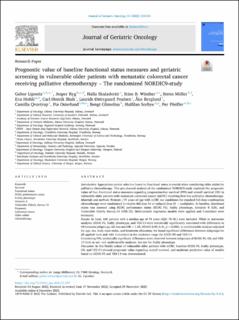Prognostic value of baseline functional status measures and geriatric screening in vulnerable older patients with metastatic colorectal cancer receiving palliative chemotherapy – The randomized NORDIC9-study
| dc.contributor.author | Liposits, Gabor Isivan | |
| dc.contributor.author | Ryg, Jesper | |
| dc.contributor.author | Skuladottir, Halla | |
| dc.contributor.author | Winther, Stine B. | |
| dc.contributor.author | Möller, Sören | |
| dc.contributor.author | Hofsli, Eva | |
| dc.contributor.author | Shah, Carl-Henrik | |
| dc.contributor.author | Poulsen, Laurids Østergaard | |
| dc.contributor.author | Berglund, Åke | |
| dc.contributor.author | Qvortrup, Camilla | |
| dc.contributor.author | Osterlund, Pia | |
| dc.contributor.author | Glimelius, Bengt | |
| dc.contributor.author | Sorbye, Halfdan | |
| dc.contributor.author | Pfeiffer, Per | |
| dc.date.accessioned | 2023-03-01T10:09:05Z | |
| dc.date.available | 2023-03-01T10:09:05Z | |
| dc.date.created | 2022-12-24T12:45:23Z | |
| dc.date.issued | 2023 | |
| dc.identifier.issn | 1879-4068 | |
| dc.identifier.uri | https://hdl.handle.net/11250/3054900 | |
| dc.description.abstract | Introduction Appropriate patient selection based on functional status is crucial when considering older adults for palliative chemotherapy. This pre-planned analysis of the randomized NORDIC9-study explored the prognostic value of four functional status measures regarding progression-free survival (PFS) and overall survival (OS) in vulnerable older patients with metastatic colorectal cancer (mCRC) receiving first-line palliative chemotherapy. Materials and methods Patients ≥70 years of age with mCRC not candidates for standard full-dose combination chemotherapy were randomized to receive full-dose S1 or reduced-dose S1 + oxaliplatin. At baseline, functional status was assessed using ECOG performance status (ECOG PS), frailty phenotype, Geriatric 8 (G8), and Vulnerable Elderly Survey-13 (VES-13). Multivariable regression models were applied and C-statistics were estimated. Results In total, 160 patients with a median age of 78 years (IQR: 76–81) were included. While in univariate analyses, ECOG PS, frailty phenotype, and VES-13 were statistically significantly associated with differences in OS between subgroups, G8 was not (HR = 1.55, 95%CI: 0.99–2.41, p = 0.050). In multivariable analyses adjusted for age, sex, body mass index, and treatment allocation, we found significant differences between subgroups for all applied tools and with C-statistics in the moderate range for ECOG PS and VES-13. Concerning PFS, statistically significant differences were observed between subgroups of ECOG PS, G8, and VES-13 both in uni- and multivariable analyses, but not for frailty phenotype. Discussion In this Nordic cohort of vulnerable older patients with mCRC, baseline ECOG PS, frailty phenotype, G8, and VES-13 showed prognostic value regarding overall survival, and moderate predictive value of models based on ECOG PS and VES-13 was demonstrated. | en_US |
| dc.language.iso | eng | en_US |
| dc.publisher | Elsevier | en_US |
| dc.rights | Navngivelse 4.0 Internasjonal | * |
| dc.rights.uri | http://creativecommons.org/licenses/by/4.0/deed.no | * |
| dc.title | Prognostic value of baseline functional status measures and geriatric screening in vulnerable older patients with metastatic colorectal cancer receiving palliative chemotherapy – The randomized NORDIC9-study | en_US |
| dc.type | Journal article | en_US |
| dc.type | Peer reviewed | en_US |
| dc.description.version | publishedVersion | en_US |
| dc.rights.holder | Copyright 2022 The Author(s) | en_US |
| dc.source.articlenumber | 101408 | en_US |
| cristin.ispublished | true | |
| cristin.fulltext | original | |
| cristin.qualitycode | 1 | |
| dc.identifier.doi | 10.1016/j.jgo.2022.11.007 | |
| dc.identifier.cristin | 2097330 | |
| dc.source.journal | Journal of Geriatric Oncology | en_US |
| dc.identifier.citation | Journal of Geriatric Oncology. 2023, 14 (1), 101408. | en_US |
| dc.source.volume | 14 | en_US |
| dc.source.issue | 1 | en_US |
Tilhørende fil(er)
Denne innførselen finnes i følgende samling(er)
-
Department of Clinical Science [2311]
-
Registrations from Cristin [9706]

